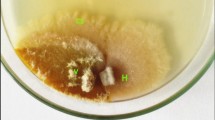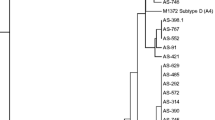Abstract
Hypovirulent strains of the chestnut blight fungus Cryphonectria parasitica have not been registered in the autonomous region of Castilla y León (Spain), except in the province of León. In this laboratory-based study, we analyzed the rates of horizontal transmission of hypovirus CHV1 subtype F1, isolated from chestnut stands in León. We tested the conversion capacity of the six vegetative compatibility (vc) types of C. parasitica isolates most commonly distributed in Castilla y León (EU1, EU11, EU12, EU66, CL5 and CL6). We investigated conversion rates of virulent isolates into hypovirulent isolates between pairings of isolates of the same vc type (EU1, EU11 and CL6) and also tested cross conversion rates between isolates of different vc types (EU1, EU11 and CL6 as donors and EU12, EU66, CL5 and CL6 as recipients). We carried out the hypovirus transmission assay with 1700 pairings, of which 700 had donor and recipient isolates of the same vc type and 1000 pairings of isolates had different vc types. Our results show that the conversion frequency to hypovirulent isolates was significantly affected by the vc type, the genotype of isolates with the same origin (province) and the interaction between both factors. In the conversion between isolates of the same vc type, the conversion rates were better with EU1 (ranging between 56 and 94 %) than with EU11 (varying from 4 to 58 %). In the cross conversion between donor and recipient isolates of different vc types, only CL5 and CL6 recipients were converted and the conversion of recipient isolates of EU12 and EU66 failed in all cases. For CL5 as recipient isolate, the conversion rates were similar with EU11 and CL6 as the donor isolates. Recipient isolates of CL6 had good conversion with donor isolates from the same vc type (CL6) and in cross conversion the results were better with donor EU1. Fungal isolates from chestnut stands in León displayed the best conversion rates, followed by those from Zamora, Salamanca and Ávila when the donor and the recipient isolates were of the same vc type. The fungal isolates appear to have a strong influence on the transmission rate of the hypovirus, at least between strains isolated from chestnut stands in Castilla y León. EU1 isolates were more susceptible to conversion than the isolates from EU11. The results highlight the differences in hypovirus transmission, regarding vc types and the genotype of isolates from the same province, when donor and recipient isolates are of the same vc type. Further transmission assays would be useful to determine why hypovirus transmissions, when compared to the hypovirus transmission of other European assays, have different conversion rates with fungal isolates from Castilla y León.




Similar content being viewed by others
References
Akilli, S., Serce, C. U., Katircioglu, Y. Z., Maden, S., & Rigling, D. (2013). Characterization of hypovirulent isolates of the chestnut blight fungus, Cryphonectria parasitica from the Marmara and Black Sea regions of Turkey. European Journal of Plant Pathology, 135, 323–334.
Allemann, C., Hoegger, P., Heiniger, U., & Rigling, D. (1999). Genetic variation of Cryphonectria hypoviruses (CHV1) in Europe, assessed using RFLP markers. Molecular Ecology, 8, 843–854.
Anagnostakis, S. L., & Day, P. R. (1979). Hypovirulence conversion in Endothia parasitica. Phytopathology, 69, 1226–1229.
Bragança, H., Simões, S., Onofre, N., Tenreiro, R., & Rigling, D. (2007). Cryphonectria parasitica in Portugal: diversity of compatibility types, mating types, and occurrence of hypovirulence. Forest Pathology, 37, 391–402.
Brusini, J., & Robin, C. (2013). Mycovirus transmission revisited by in situ pairings of vegetatively incompatible isolates of Cryphonectria parasitica. Journal of Virological Methods, 187, 435–442.
Bryner, S. F., & Rigling, D. (2011). Temperature-dependent genotype-by-genotype interaction between a pathogenic fungus and its hyperparasitic virus. The American Naturalist, 177, 65–74.
Bryner, S. F., & Rigling, D. (2012). Virulence not only costs but also benefits the transmission of a fungal virus. Evolution, 66, 2540–2550.
Bryner, S. F., Rigling, D., & Brunner, P. C. (2012). Invasion history and demographic pattern of Cryphonectria hypovirus 1 across European populations of the chestnut blight fungus. Ecology and Evolution, 2, 3227–3241.
Castaño, C., Bassie, L., Oliach, D., Gómez, M., Medina, V., Liu, B., & Colinas, C. (2015). Cryphonectria hypovirus 1 (CHV-1) survey reveals los occurrence and diversity of subtypes in NE Spain. Forest Pathology, 45, 51–59.
Choi, H. G., Dawe, A. L., Churbanov, A., Smith, M. L., Milgroom, M. G., & Nuss, D. L. (2012). Molecular characterization of vegetative incompatibility genes that restrict hypovirus transmission in the chestnut blight fungus Cryphonectria parasitica. Genetics, 190, 113–127.
Colinas, C., Rojo, M., Argemí, J., Heras, J., Castaño, C., Rotllan, X., Gómez, M., Gilarte, S., Ustrell, E., Sarri, H., 2009. El control biológico del chancro del castaño en Cataluña. 5° Congreso Forestal Español. Septiembre 2009. Ávila, Spain.
Cortesi, P., & Milgroom, M. G. (1998). Genetics of vegetative incompatibility in Cryphonectria parasitica. Applied and Environmental Microbiology, 64, 2988–2994.
Cortesi, P., McCulloch, C. E., Song, H., Lin, H., & Milgroom, M. G. (2001). Genetic control of horizontal virus transmission in the chestnut blight fungus, Cryphonectria parasitica. Genetics, 159, 107–118.
Dawe, A., & Nuss, D. (2001). Hypoviruses and chestnut blight: exploiting viruses to understand and modulate fungal pathogenesis. Annual Review of Genetics, 35, 1–29.
Deng, Q. C., Ye, Y., Miao, M., Qin, F., Tao, L., & KeRong, W. (2009). The horizontal transmission of Cryphonectria hypovirus 1 (CHV1) is affected by virus strains. Chinese Science Bulletin, 54, 3053–3060.
Ding, P., Liu, F., Xu, C. H., & Wang, K. (2007). Transmission of Cryphonectria hypovirus to protect chestnut trees from chestnut blight disease. Biological Control, 40, 9–14.
Gobbin, D., Hoegger, P. J., Heiniger, U., & Rigling, D. (2003). Sequence variation and evolution of Cryphonectria hypovirus 1 (CHV1) in Europe. Virus Research, 97, 39–46.
González-Varela, G., González, A. J., & Milgroom, M. G. (2011). Clonal population structure and introductions of the chestnut blight fungus, Cryphonectria parasitica, in Asturias, northern Spain. European Journal of Plant Pathology, 131, 67–79.
Heiniger, U., & Rigling, D. (1994). Biological control of chestnut blight in Europe. Annual Review of Phytopathology, 32, 581–599.
Hillman, B. I., & Suzuki, N. (2004). Viruses of the chestnut blight fungus, Cryphonectria parasitica. Advances in Virus Research, 63, 423–472.
Homs, G., Rodriguez, J., Rigling, D., Colinas, C. (2001).Caracterización de la población de Cryphonectria parasitica y detección de cepas hipovirulentas en 3 subpoblaciones de Cataluña. Montes para la sociedad del nuevo milenio. III Congreso Forestal Español. Ed. Junta de Andalucía. Granada.
Krstin, L., Novak-Agbaba, S., Rigling, D., Krajačić, M., & Ćurković Perica, M. (2008). Chestnut blight fungus in Croatia: diversity of vegetative compatibility types, mating types and genetic variability of associated Cryphonectria hypovirus 1. Plant Pathology, 57, 1086–1096.
Krstin, L., Novak-Agbaba, S., Rigling, D., & Ćurković-Perica, M. (2011). Diversity of vegetative compatibility types and mating types of Cryphonectria parasitica in Slovenia and occurrence of associated Cryphonectria hypovirus 1. Plant Pathology, 60, 752–761.
Liu, Y. C., & Milgroom, M. G. (1996). Correlation between hypovirus transmission and the number of vegetative incompatibility (vic) genes different among strains form a natural population of Cryphonectria parasitica. Phytopathology, 86, 79–86.
Milgroom, M. G., & Cortesi, P. (2004). Biological control of chestnut blight with hypovirulence: a critical analysis. Annual Review of Phytopathology, 42, 311–338.
Milgroom, M. G., Sotirovski, K., Spica, D., Davis, J. E., Brewer, M. T., Milevs, M., & Cortesi, P. (2008). Clonal population structure of the chestnut blight fungus in expanding ranges in southeastern Europe. Molecular Ecology, 17, 4446–4458.
Montenegro, D., Aguín, O., Sainz, M. J., Hermida, M., & Mansilla, J. P. (2008). Diversity of vegetative compatibility types, distribution of mating types and occurrence of hypovirulence of Cryphonectria parasitica in chestnut stands in NW Spain. Forest Ecology and Management, 256, 973–980.
Morris, T. J., & Dodds, J. A. (1979). Isolation and analysis of double-stranded RNA from virus infected plant and fungal tissue. Phytopathology, 69, 854–858.
Papazova-Anakieva, I., Sotirovski, K., Cortesi, P., & Milgroom, M. G. (2008). Horizontal transmission of hypoviruses between vegetative compatibility types of Cryphonectria parasitica in Macedonia. European Journal of Plant Pathology, 120, 35–42.
Rigling, D., Heiniger, U., & Hohl, H. R. (1989). Reduction of laccase activity in dsRNA-containing hypovirulent strains of Cryphonectria (Endothia)parasitica. Phytopathology, 79, 219–223.
Peters, F. S., Bußkamp, J., Prospero, S., Rigling, D., Metzler, B. (2014). Genetic diversification of the chestnutblight fungus Cryphonectria parasitica and its associated hypovirus in Germany. Fungal Biology, 118, 193–210.
Robin, C., Lanz, S., Soutrenon, A., & Rigling, D. (2010). Dominance of natural over released biological control agents of the chestnut blight fungus Cryphonectria parasitica in south-eastern France is associated with fitness-related traits. Biological Control, 53, 55–61.
Sotirovski, K., Milgroom, M. G., Rigling, D., & Heiniger, U. (2006). Ocurrence of the Cryphonectria hypovirus 1 in the chestnut blight fungus in Macedonia. Forest Pathology, 36, 136–143.
Sotirovski, K., Rigling, D., Heiniger, U., & Milgroom, M. G. (2011). Variation in virulence of Cryphonectria hypovirus 1 in Macedonia. Forest Pathology, 41, 59–65.
Van Alfen, N. K. (1982). Biology and potential for disease control of hypovirulence of Endothia parasitica. Annual Review of Phytopathology, 20, 349–362.
Zamora, P., Martín, A. B., Rigling, D., & Diez, J. J. (2012). Diversity of Cryphonectria parasitica in western Spain and identification of hypovirus- infected isolates. Forest Pathology, 42, 412–419.
Zamora, P., Martín, A. B., San Martín, R., Martínez-Álvarez, P., & Diez, J. J. (2014). Control of chestnut blight by the use of hypovirulent strains of the fungus Cryphonectria parasitica in northwestern Spain. Biological Control, 79, 58–66.
Acknowledgments
This research was supported by grants provided by the Regional Government of Castilla y León and the project “Control biológico del chancro del castaño en Castilla y León” VA053A08.
Author information
Authors and Affiliations
Corresponding author
Rights and permissions
About this article
Cite this article
Zamora, P., Martín, A.B., Dueñas, M. et al. Cryphonectria parasitica isolates of the same vegetative compatibility type display different rates of transfer of CHV1 hypovirus. Eur J Plant Pathol 143, 767–777 (2015). https://doi.org/10.1007/s10658-015-0727-3
Accepted:
Published:
Issue Date:
DOI: https://doi.org/10.1007/s10658-015-0727-3




